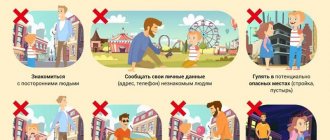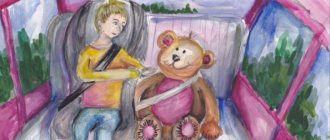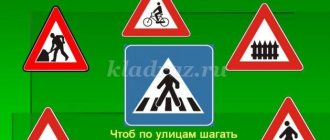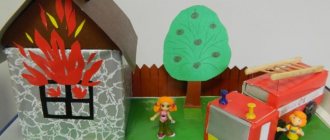Consultation for kindergarten parents on traffic rules
Consultation for parents “The road safety of your child depends on you”
The speed of movement and the density of traffic flows on the streets and roads of our country are rapidly increasing, and will continue to progress in the future.
Of particular importance in solving this problem is the early and correct preparation of our youngest pedestrians - children, who are already facing serious difficulties and dangers outside the gates of their homes, and who will have to live with an incomparably greater intensity of automobile traffic. Unfortunately, many parents have the misconception that their child should be taught safe behavior on the streets closer to the time when he goes to kindergarten or school. But it’s dangerous to think like that! After all, children develop a whole set of habits (unbeknownst to him and to us) from early childhood. Including demeanor. Therefore, the safety of a preschooler largely depends on what knowledge his parents instill in his head in early childhood. Children under the age of five do not realize the full danger of the world around them, cannot think ahead, and live only in the present, without thinking about the consequences that one or another of their actions may lead to. At this age, it is very important to ensure the safety of the preschooler and put into his head the knowledge that he should analyze his actions a little and think about the consequences. The best way to save your life and the life of your child on the roads is to follow the traffic rules! The question may arise: why explain to children the peculiarities of traffic, the rules of crossing the street, if children cross the road only holding the hand of an adult? Perhaps we shouldn’t bother them with these rules while they still don’t walk the streets on their own or use public transport? But we must always remember that the formation of conscious behavior is a long process. Today a child walks everywhere hand in hand with his mother, and tomorrow he will become an independent pedestrian and passenger of city transport. Work on teaching children the rules of competent and safe behavior on city streets and in public transport must be systematic. In order for it to bring the necessary results, one lesson or conversation with children is not enough. And one more important requirement: children do not have enough theoretical knowledge, they must apply it in practice. It is important that parents set an example for their children in following traffic rules. Take your time, cross the road at a measured pace. When going out onto the road, stop talking - the child must get used to the fact that when crossing the road you need to concentrate. Do not cross the road when the traffic light is red or yellow. Cross the road only in places marked with a “Pedestrian Crossing” road sign . Get off the bus, trolleybus, tram, taxi first. Otherwise, the child may fall or run onto the road. Invite your child to participate in your observations of the situation on the road: show him those cars that are preparing to turn, driving at high speed, etc. Do not leave with your child from behind a car or bushes without first inspecting the roads - this is a typical mistake, and children should not be allowed to repeat it. Do not allow children to play near roads or on the roadway. It is enough to have a conversation-game with your child on the rules of the road at least once a week for 10-15 minutes so that he looks at the situation with different eyes. Such a child will later be able to navigate independently in difficult situations on city highways. At the height of the summer holidays, many children go on vacation outside the city and find themselves in a completely different, unusual environment for them. And if the child is well versed in the rules of the road, parents can be calm about him. A common mistake made in such cases is the wrong approach to starting a conversation. Talking to children about the dangers of the road in an overly stern tone is ineffective. In this case, the child will not be interested in the conversation and, as a result, will learn only a small part of the information. It is much more effective to talk to your child calmly, choosing a moment when he is not busy with anything and his attention is at your disposal. Before explaining, indicate the importance and seriousness of the conversation, let the baby feel his importance. His attention near the road should be a request, not a demand. He must understand that they are worried about him and that he is in danger. This motivation is much stronger than fears of punishment or reproaches. To prevent your child from getting into trouble, teach him respect for the rules of the road patiently, daily, unobtrusively. The child should only play in the yard under your supervision. He must know: you can’t go out on the road. Do not intimidate the child, but watch with him and take advantage of the situation on the road, yard, street; Explain what happens to transport and pedestrians.
Develop your child’s visual memory and attention, and to do this, create various play situations at home. You are a model of behavior for children, you are an object of love and imitation for a child. This must always be remembered, and even more so when you take a step onto the roadway with your baby.
We recommend watching:
Consultation for parents in kindergarten. Road safety Consultation for parents. Dangerous intersections Consultation for parents “Teaching preschoolers traffic rules in the family” Children’s safety on the road. Consultation for parents of preschool children
Similar articles:
Consultation for parents on traffic rules. Children's safety is the concern of adults
MAGAZINE Preschooler.RF
Consultation for parents “Parents about road safety”Children, due to their age, are not always able to correctly assess the road situation and recognize danger. Do everything necessary to prevent danger from coming to your family. Timely teaching children the ability to navigate traffic situations, cultivate the need to be disciplined on the street, careful and prudent!
Remember, if you break the Rules, your child will do the same!
Teach your children the rules for safely crossing the road!
Discuss together the safest routes to travel, remind your child every day: BEFORE CROSSING THE ROAD, MAKE SURE IT IS SAFE!
Explain to your child that stopping the car right away is impossible! Learn to anticipate hidden dangers!
Discuss the safest routes together!
It is important for the child to remember that even a familiar, familiar road can be dangerous.
Dedicate a separate walk to the rules of crossing the road, check whether your child understands them correctly and knows how to use this knowledge in real traffic situations. To do this, practice crossing a pedestrian crossing together, across a one-way roadway, through controlled and uncontrolled intersections.
Walk with your child along the usual route to and from school. Talk about why it is important to walk the same path. Draw your child’s attention to all the dangers and hidden “traps” that may lie in wait for him along the way, think over the route so that it becomes safer.
Make sure that the child always has some extra time, but if the child is still late somewhere, explain to him that rushing on the road is not acceptable, and it is better to be late, but remain alive and healthy.
If you are driving a car: be sure to use a special restraint system and seat belts, buckle up yourself and make sure that the passengers in the car are buckled up. About 30% of children injured in road accidents are passengers.
During the holidays, it doesn’t matter whether your child stays in the city or leaves. It is necessary to use every opportunity to remind him of the rules of the road. Do not allow children to play near the roadway; there are closed playgrounds, stadiums, and gyms for games.
A stationary car is dangerous: it can block your view and make it difficult to notice the danger in time. You cannot go out onto the road because of parked cars. As a last resort, you need to carefully look out from behind a standing car, make sure that there is no danger, and only then cross the road.
Do not go around a stationary bus, either in front or behind!
From the stop you need to move towards the nearest pedestrian crossing. And after making sure of your safety, cross the road at a pedestrian crossing.
A slow moving car can hide behind a car going at high speed. A child often does not suspect that another car may be hidden behind one car.
It is not enough to teach children how to navigate when a traffic light is green; before you take a step onto the road, you need to make sure that cars are stopping or allowing you to pass.
On a street where cars rarely appear, children run out onto the road without first checking it and get hit by a car. Develop in your child the habit of always stopping before going out onto the road, looking around, listening, and only then crossing the street.
If you had to stop in the middle of the road, you need to be extremely careful, remember that cars are moving behind you. You cannot make a single movement without making sure it is safe.
Being next to an adult, the child relies on him and either does not watch the road at all or does not watch well. An adult does not take this into account. On the street, children are distracted by all sorts of objects and sounds, not noticing a moving car, and thinking that the way is clear, they break away from the hands of an adult and run across the road. Before crossing the road, hold your child's hand tightly.
In large cities, places of increased danger are arches and exit points from courtyards. Do not allow a child to run past a yard exit or arch ahead of an adult.
Teach children to follow traffic rules from an early age. And don’t forget that personal example is the most intelligible form of learning.
REMEMBER! The child learns the laws of the street, following the example of you, parents, and other adults. Let your example teach disciplined behavior on the street not only to your child, but also to other children.
Recommendations for parents
1. When driving on the sidewalk:
- keep to the right side of the sidewalk
- do not lead the child along the edge of the sidewalk: the adult must be on the side of the roadway
2. When preparing to cross the road:
- stop or slow down, look at the roadway
- involve your child in observing the situation on the road
- emphasize your movements: turning your head to look around the street, stopping to look around the road, stopping to let cars pass
- teach your child to recognize approaching vehicles
- do not stand with your child on the edge of the sidewalk, as when passing the vehicle can get caught, knocked down, or run over with its rear wheels
— repeatedly show your child how the vehicle stops at the crossing, how it moves by inertia.
3. When leaving home:
- immediately draw your child’s attention to the movement of vehicles at the entrance and together look to see if a car, motorcycle, moped, or bicycle is approaching you
— if there are vehicles at the entrance or trees growing that block your view, stop your movement and look around to see if there is any danger behind the obstacle.
4. When waiting for public transport:
- stand with children only on landing platforms, and if there are none, on the sidewalk or curb.
5. When crossing the roadway:
- cross the road only at pedestrian crossings or at intersections along the marked zebra line, otherwise the child will get used to crossing wherever he has to
- do not rush and do not run; always cross the road at a measured pace
- do not cross the road diagonally; Emphasize, show and tell your child every time that you are walking strictly across the street, that this is being done for better observation of cars and motor vehicles
- do not rush to cross the road if you see friends, relatives, or acquaintances on the other side. Don’t rush and don’t run towards them; instill in your child that this is dangerous.
- Don't start crossing a street where traffic rarely passes without looking around.
- Explain to your child that cars can unexpectedly leave the alley or the yard of the house
6. When boarding and disembarking from public transport:
- go out in front of the child, as the baby may fall, and an older child may run out of the parked vehicle onto the roadway
- approach the vehicle door only after a complete stop: a child, like an adult, can trip and get run over
- do not board public transport at the last moment when it departs; The front door is especially dangerous, as you can get under the wheels of a vehicle
— teach your child to be careful in the bus stop area, a particularly dangerous place for him: a stopped bus reduces the view of the road in this area.
7. When the car is moving:
- teach children to sit in the car only in the back seat; do not allow sitting next to the driver unless the front seat is equipped with a child seat
- Do not allow a small child to stand in the back seat while driving: in the event of a collision or sudden stop, he may fly over the back of the seat and hit the front window
- Do not allow children to be in the vehicle unattended.
Reminder for parents: Safe steps towards road safety.
What should parents know about their child?
At 3-4 years old, a child can distinguish a moving car from a stationary one, but he is sure that the car stops instantly.
At 6 years old - with peripheral vision he sees approximately 2/3 of what adults see; cannot determine what is moving faster: a bicycle or a sports car; does not know how to correctly distribute attention and separate the essential from the insignificant.
At 7 years old, you can more confidently distinguish the right side of the road from the left.
At 8 years old - can instantly respond to feedback, etc.; has experience of walking on the road; actively masters basic cycling skills; can determine the source of noise; establish a connection between the size of an object, its distance and time (the closer the car, the larger it is).
Educator: Amelchenko V.A.
| Next > |
Recommendations for parents on teaching children road safety rules
Solodovnikova Svetlana Alekseevna
Recommendations for parents on teaching children road safety rules
Teach your children how to behave safely on the road by example ! The situation on the roads is tense and dangerous. It is necessary to remember that your behavior on the road , conversations, just mentions of safe behavior on the road should not be occasional, but constant.
It is important to teach them to observe, navigate the situation on the road , assess and anticipate danger. The development of observation and orientation skills in traffic situations depends on adults. While on the road with your children , constantly use some methods that will help you and your child develop safe behavior .
1. Never rush on the roadway; cross the road only at a measured pace.
2. Don’t talk while crossing the road , no matter how interesting the topic of conversation is, then the child will understand that he should not be distracted while crossing the maneuver.
3. Never cross the road diagonally , not to mention at intersections. Show that the correct and therefore safe crossing is only strictly across the road .
4. Do not cross the road at a red or yellow traffic light, no matter how much you are in a hurry. This is not just a one-time danger. He will do the same without you.
5. Train yourself and teach your children to cross the road not where you need it, but where there are crossings.
6. Crossing the roadway. Or rather, from crossing the road by young mothers with strollers. According to numerous observations, almost all parents with strollers cross the road incorrectly : they roll it in front of them, not paying attention to the fact that the stroller is lower than the parked car, and the driver simply cannot see it from the road .
There are three options for crossing the roadway with a stroller.
The first is when we push it in front of us. This is the most common and most dangerous method. Why is he dangerous? Even if one, the right row of cars stopped to let you pass, then from the second, left row, the driver may not notice the stroller, since it is below the level of the car. the road is lost , and therefore control over the situation.
The second option is that we carry the stroller behind us. Also unsafe , because in this case we control the situation in front of us, but do not see what is happening behind us.
The safest is the third method , when we keep the stroller on the right side of us . Only in this case does the mother have the opportunity, if a critical situation arises, to pull the stroller back or push it forward.
In winter, some parents take their children on sleds . And here there are peculiarities. The sled is even lower than the stroller, and in this case the risk that the driver will not notice them when turning is even higher. It is impossible to carry a sled on your side, so the only correct solution is to take the child in your arms.
The same goes for bicycles. We often see this picture in the summer. A mother is crossing the road , and a child is riding next to her on a tricycle. And the mother does not understand that at this moment the baby is completely unprotected. If he just runs over a pebble, the baby will lose his balance and fall off the bike onto the roadway. Before going out onto the road , the child must get off the bike. Agree, it is not difficult for a mother to carry a tricycle in one hand, and with the other to take her child by the hand and move him. Moreover, here, as with a stroller, “ right hand ” rule
- the child should always be
to the right of the adult . And you need to hold him not by the hand, but by the wrist. The child is unpredictable: if he suddenly sees something on the other side of the road and runs , his palm will easily slip out of your hand.
Finally, when crossing the road , do not talk on the phone, do not be distracted - “listen”
street. In order to react in time to the signal that a driver can give in case of danger, or to the whistle of a policeman who regulates traffic.
7. When getting off a bus, tram, taxi, remember that you must do this first in order to control the further movement of your children .
8. You cannot walk around the bus, neither in front nor behind. You need to wait until the bus leaves and then cross the pedestrian crossing.
traffic situations with your child , pointing out obvious or hidden dangers.
10. Pay special attention to children’s : stopping before crossing, turning their head left, right , left again to assess the situation on the road ; everything should be recorded by the child so that he, if necessary, can copy your behavior. Be sure to develop a solid skill - take the first step onto the roadway, turn your head, look left, then look to the right and left again, and only after making sure that there are no cars, cross the road .
11. Never go out onto the road from cover in the form of a car or bush, thereby demonstrating the bad habit of unexpectedly appearing on the roadway.
12. Teach to peer into the distance and estimate the speed of approaching modes of transport in order to be able to calculate the time in which a car or motorcycle can get to you.
13. Pay attention to the deceptiveness of deserted roads , they are no less dangerous than busy ones. Not expecting to encounter danger on it, a person exposes his life to even greater danger.
14. Particular attention should be paid to children with vision problems. Lateral vision, which plays a huge role when crossing the street, is less developed in children with impaired vision. Teach them to turn their heads more often to assess the situation on the road .
Remember that the life and safety of children on the roads depends , first of all, on us, adults.
NEVER VIOLATE THE TRAFFIC RULES !
REMEMBER!
The child learns the laws of the street, following the example of YOU - the parents ! It is the duty of adults to protect a child from harm on .
Practical training of children to monitor the traffic situation should be carried out by parents from the first joint walks on the street. Repeated observation of situations and movement training will help instill in children the necessary skills for safe behavior on the street . It is very convenient for these purposes to use the route to kindergarten, school and back.
PARENTS NEED:
• Know where their children spend their free time;
• Constantly monitor the behavior of children while playing in the yard, residential area, or moving along the sidewalk;
• Hold children by the hand when crossing busy roads the rules of safe behavior on the road network ;
• Ensure that children reflective elements on their clothing and accessories;
• Remember personal responsibility for the behavior of your children .
The joint work of an educational institution and a family is successful in conditions of active participation of parents in preventive measures for safe life .
Memo for parents on teaching children to behave safely on the road
Causes of children's road traffic injuries .
- Inability to observe.
- Inattention.
— Insufficient adult supervision of children’s
Recommendations for teaching children traffic rules
When leaving home
If there is possible movement at the entrance of the house, immediately pay attention to the child to see if there is any approaching traffic. If there are vehicles parked at the entrance or trees growing, stop your movement and look around to see if there is any danger.
When driving on the sidewalk
• Keep to the right .
• The adult must be on the side of the roadway.
• If the sidewalk is next to a road , parents should hold the child's hand.
• Teach your child, when walking along the sidewalk, to carefully watch cars leaving the yard.
• Do not encourage children to go out onto the roadway; push strollers and sleds only on the sidewalk.
Getting ready to cross the road
• Stop and look at the roadway.
• Develop your child's observation of the road .
•Emphasize your movements: turning your head to scan the road . Stop to inspect the road , stop to let cars through.
• Teach your child to peer into the distance and distinguish approaching cars.
• Do not stand with your child on the edge of the sidewalk.
• Draw the child's attention to a vehicle preparing to turn, talk about the turn signal signals on cars.
• Show how the vehicle stops at the crossing, how it moves by inertia.
When crossing the roadway
• Cross the road only at a pedestrian crossing or at an intersection.
• Go only when the traffic light is green, even if there are no cars.
• When going out onto the roadway, stop talking.
• Don't rush, don't run, cross the road slowly .
• Do not cross the street at an angle; explain to your child that this makes it harder to see the road .
• Do not go out onto the roadway with your child because of vehicles or bushes without first inspecting the street.
• Do not rush to cross the road , if on the other side you see friends, the right bus, teach your child that this is dangerous.
• When crossing an uncontrolled intersection, teach your child to carefully watch for the start of traffic.
• Explain to your child that even on a road where there are few cars, you must cross carefully, as a car may drive out of the yard or alley.
When boarding and disembarking from transport
• Get out first, in front of the child, otherwise the child may fall or run out onto the roadway.
• Approach the door to board only after coming to a complete stop.
• Do not get into transport at the last moment (you may get caught in the doors)
.
• Teach your child to be careful in the stopping area - this is a dangerous place (poor view of the road , passengers can push the child onto the road ).
While waiting for transport
• Stand only on landing areas, sidewalks or curbs.
Recommendations for developing street behavior skills
•Skill of switching to the street: when approaching the road , stop, look around the street in both directions .
• The skill of calm, confident behavior on the street: when leaving home, do not be late, leave in advance so that you have some time to spare when walking calmly.
•The skill of switching to self-control: the ability to monitor one’s behavior is developed daily under the guidance of parents .
•The skill of anticipating danger: the child must see with his own eyes that danger is often hidden behind various objects on the street.
It is important that parents set an example for their children in following traffic rules .
• Take your time, cross the road at a measured pace .
• When going out onto the roadway , stop talking - the child must get used to the fact that when crossing the road you need to concentrate.
• Do not cross the road when the traffic light is red or yellow.
• Cross the road only in places marked with “Pedestrian Crossing” road sign.
.
• Get off the bus, trolleybus, tram, taxi first. Otherwise, the child may fall or run onto the roadway .
• Invite your child to participate in your observations of the situation on the road : show him those cars that are preparing to turn, driving at high speed, etc.
• Do not leave with your child from behind a car or bushes without first checking the roads - this is a typical mistake, and children should not be allowed to repeat it.
• Do not allow children to play near roads or on the roadway.
Accident on public transport.
Your actions:
1. Stay calm.
2. If you feel a push or blow, try to instantly regroup by covering your head with your hands. Grab onto something to avoid falling, getting hurt, or being thrown around the cabin if possible.
3. Open the emergency exit, which is usually located in a window. To do this, you need to pull out the cord from the rubber seal of the window and squeeze out the glass or break it with a hammer located in the cabin.
4. If a fire starts in the cabin, try to put it out with a fire extinguisher.
5. In the event of a short circuit, it is necessary to leave the tram or trolleybus only when the driver stops it and turns off the electrical circuits.
Children do not need teachings, but examples. Joseph Joubert
The eyes of our children are small “cameras” with which they record everything that happens in the family. Children, especially at a younger age, constantly monitor their parents and do not miss a single gesture or word. They analyze the behavior of their parents, copy their parents. You can often hear such words from an adult. My mother did it that way, so I do it too. Or, my father did it, so I do it too.
Is it easy to teach a child to behave correctly on the road? At first glance it seems easy. You just need to introduce him to the basic requirements of the Traffic Rules and there will be no problems.
It's actually very difficult. After all, parents often violate these same Rules in front of their children, and do not think that they are setting an impossible task for their child: what is the right way? What do they say or what do they do?
Before you cross the road with your child in your arms or in a stroller for the first time, learn to behave on the street the way you would like your child to do.
When a child gets into a traffic accident, everyone is to blame: the driver, the kindergarten, the school, and the State Traffic Inspectorate. Why didn’t they teach you, show you, or save you? Forgetting that, first of all, parents must teach and protect by their example.
If you are really interested in your child having the skills to behave safely on the road, then do not reduce the learning process to an empty and useless phrase: “Be careful on the road”; it does not explain to the child what exactly he should be afraid of on the road. Where might he be in danger? Better use driving to and from kindergarten to practice road behavior skills.
The child must firmly know that the road can only be crossed in designated places: at a pedestrian crossing and at an intersection. But even in this case, no one can guarantee its safety.
- Cross the street only when the traffic light is green or in specially designated areas - marked with white zebra stripes;
- When crossing the street, you should always look left first, and when you reach the middle of the road, look right.
- It is safest to cross the street with a group of pedestrians.
- Walk around the back of the bus.
- You cannot play on the roadway or on the sidewalk.
- You should walk along the sidewalk as far away from the roadway as possible.
Due to the lack of long-term personal experience, all knowledge about safe behavior on the road should come directly from parents, who are obliged not only to teach and tell, but also to set the right example. Just crossing a red light hand in hand with your dad can negate all the road safety knowledge you have acquired up to that point. It is important that parents set an example for their children in following traffic rules!
- Don't rush, cross the road at a measured pace!
- When going out onto the road, stop talking - the child must get used to the fact that when crossing the road you need to concentrate.
- Do not cross the road when the traffic light is red or yellow.
- Cross the road only in places marked with the “Pedestrian Crossing” road sign.
- Get off the bus, trolleybus, tram, taxi first. Otherwise, the child may fall or run onto the road.
- Invite your child to participate in your observations of the situation on the road: show him those cars that are preparing to turn, driving at high speed, etc.
- Dedicate a separate walk to the rules of crossing the road. Check whether your child understands them correctly and knows how to use this knowledge in real driving situations. To do this, practice crossing a pedestrian crossing together through a one-way and two-way roadway, through controlled and unregulated intersections.
If your child is soon going to first grade, then now walk with him repeatedly along the route from home to school and back, drawing the child’s attention to all the dangers that he may encounter along the way. Discuss with him in advance that in a difficult situation you need to turn to the help of adults. Give your child the opportunity to go through this route on his own, watching him from the side. Then analyze in detail all his actions with him.
Dear parents, you should know that:
at 3-4 years old, a child can distinguish a moving car from a stationary one, but he is sure that the car stops instantly;
at 6 years old – the child sees with peripheral vision approximately 2/3 of what adults see; cannot determine what is moving faster: a bicycle or a sports car; does not know how to correctly distribute attention and separate the essential from the insignificant;
at 7 years old – the child more confidently distinguishes the right side of the road from the left;
at 8 years old - the child can instantly respond to a response; has experience of walking on the road; actively masters basic cycling skills; can determine the source of noise; establish a connection between the size of an object, its distance and time (the closer the car, the larger it is).
Dear parents! Teach children to follow traffic rules from an early age. And don’t forget that personal example is the most intelligible form of learning.
Senior teacher of MAU DO "Kindergarten Solnyshko" Turtas village
Uvat municipal district N.V. Stroeva
Parents' meeting in the middle group "Children's safety on the roads"
10
Parent meeting in middle group No. 10 on the topic “Children’s safety on the road.”
Goal: Pedagogical education and involvement of parents in the process of teaching preschoolers the skills of safe behavior on the roads and streets of the city, developing a sense of responsibility for the life and health of their children.
Objectives: - To familiarize parents with the theoretical foundations of road safety. — To create motivation in parents to self-develop a culture of safe behavior for children on the streets and roads. — Create conditions for interaction with society to prevent road traffic injuries among preschool children.
Agenda for the parent meeting: 1. Opening remarks. 2. Message from the group teacher. 3. Recommendations for parents on teaching children traffic rules.
4. Distributing a handout for parents “What can I do?”
Progress of the parent meeting:
1. Opening speech by the teacher:
“Our children were born to live joyfully. To play together, to be strong friends, to give smiles to each other and flowers, so that dreams always come true in their lives.”
Yes, our children are born precisely for this, but whether this always happens, whether life will be overshadowed by tragedy - this largely depends on us, adults. The topic of today's meeting is “Children's safety on the road.” The need for a meeting on traffic rules is dictated by life itself. The terrible statistics of child mortality and health damage as a result of road accidents are simply terrifying. And most often we, the adults, are to blame for tragedies. At this meeting we will talk about what parents can do to keep their child safe on the road. First of all, parents should understand that this task of protecting their child on the road is fundamentally unsolvable. Firstly, any movement by transport (and even on your own feet) is associated with danger, and the probability of the unexpected happening is always different from zero. This was not said at all to scare parents, but on the contrary, to draw their attention to the fact that you should always take care of the children’s safety (and your own). Secondly, the task of protecting the child once and for all cannot be solved, because the child is growing, and the possible dangers that await him on the road are growing. Therefore, children should be promptly taught the ability to navigate a traffic situation, cultivate the need to be disciplined on the street, careful and prudent. And parents should not make the most common mistake - acting on the principle “you can do it with me.” If you show your child by your own example how to run to red, be sure that when left alone, he will try to repeat this trick. Dear parents! Remember, if you break the Rules, your child will do the same! We have the power to develop the skills of safe behavior on the roads, to educate a conscious and competent pedestrian, responsible for the life and health of road users.








